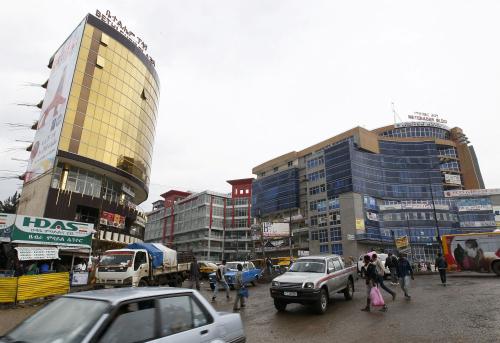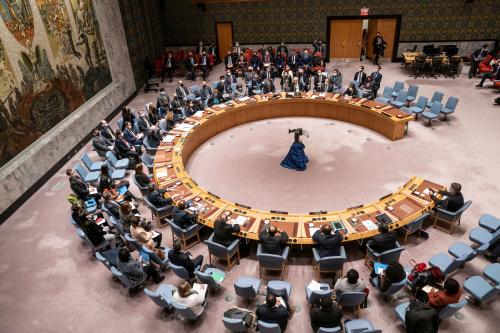The war in Ukraine could not have come at a worse time for the global economy—when the recovery from the pandemic-induced contraction had begun to falter, inflation was surging, central banks in the world’s largest economies were gearing up to hike interest rates, and financial markets were gyrating over a formidable constellation of uncertainties.
The war has aggravated those uncertainties in ways that will reverberate across the world, harming the most vulnerable people in the most fragile places. It’s too soon to tell the degree to which the conflict will alter the global economic outlook. Like the novel coronavirus, the latest crisis arrived in a largely unexpected form—in its scale and ferocity, in its location, and in the global response to it. Much will depend on what happens next. But it’s already clear that higher food and energy prices—along with supply shortages—will be the immediate inflictor of pain for low- and middle-income economies.
Many of the world’s developing economies remain debilitated by the pandemic. The healthy recovery that advanced economies have experienced over the past year has largely bypassed them: By 2023, economic output levels in developing economies will still be 4 percent below their projected levels before the pandemic. Total debt in these economies now stands at a 50-year high. Inflation is at an 11-year high, and 40 percent of central banks have begun to raise interest rates in response.
As devastating as it has been, the coronavirus pandemic was an object lesson in the power of policymakers to respond effectively to a catastrophe.
The Ukraine crisis could make it harder for many low- and middle-income economies to regain their footing. Besides higher commodity prices, the fallout is likely to arrive through several other vectors: trade shocks, financial turbulence, and remittances and the flight of refugees. Countries closest to the conflict—by virtue of their strong trade, financial, and migration links to Russia and Ukraine—are likely to suffer the greatest immediate harm. But the effects could ripple far beyond.
Food and fuel costs
Some developing economies are heavily reliant on Russia and Ukraine for food (Figure 1). These two countries supply more than 75 percent of the wheat imported by a handful of economies in Europe and Central Asia, the Middle East, and Africa. These economies are particularly vulnerable to a disruption in the production or transportation of grains and seeds from Russia and Ukraine. For lower-income countries, disruption to supplies as well as higher prices could cause increased hunger and food insecurity.
Russia is also a major force in the market for energy and metals: It accounts for a quarter of the market for natural gas, 18 percent of the coal market, 14 percent of the market for platinum, and 11 percent for crude oil. A steep drop in the supply of these commodities would hamstring construction, petrochemicals, and transportation. It would also lower economywide growth: Estimates from a forthcoming World Bank publication suggest that a 10 percent oil-price increase that persists for several years can cut growth in commodity-importing developing economies by a tenth of a percentage point. Oil prices have risen by more than 100 percent during the last 6 months. If this lasts, oil could shave a full percentage point of growth from oil importers like China, Indonesia, South Africa, and Turkey. Before the war broke out, South Africa was expected to grow by about 2 percent annually in 2022 and 2023, Turkey by 2-3 percent, and China and Indonesia by 5 percent, so a slowdown of 1 percentage point of growth means that growth will be cut by between a fifth and a half.
Financial turbulence
The conflict has already caused tremors in financial markets, prompting a sell-off in stocks and bonds in the main global markets. An increase in investor risk aversion could lead to capital outflows from developing economies, triggering currency depreciations, falling stock prices, and higher risk premiums in bond markets. That would create acute stress for the dozens of developing economies with high debt levels. Economies with high current account deficits or large shares of short-term debt denominated in foreign currencies would struggle to roll over the debt. Alternatively, they would face higher debt service obligations.
Financial stress could be aggravated by central banks’ response to higher inflation. In many developing economies, inflation is already at the highest level in a decade. A further boost from surging energy prices could lead to an inflationary spiral as expectations of higher long-term inflation become entrenched. That, in turn, could prompt central banks to tighten monetary policy more rapidly than has been expected so far.
Refugee flight and remittances
Since the conflict began, more than 2 million people have fled Ukraine into neighboring nations, marking the largest mass migration in Europe since World War II. The United Nations High Commissioner for Refugees expects the refugee numbers to climb to 4 million not before long. Accommodating the sudden arrival of a large number of newcomers is tough for host governments. It puts pressure on public finances and on service delivery—particularly health care, which remains in short supply as the pandemic stretches into its third year.
The economic pain, moreover, could radiate beyond Eastern Europe to countries that rely heavily on remittances in the affected countries. Several countries in Central Asia, for example, are heavily dependent on remittances from Russia—in some instances, these remittances account for as much as 10 percent of the country’s GDP. Many Central Asian countries are likely to see a decline in remittances as a result of the conflict.
Prevention pays
It’s time to act. The World Bank Group, in tandem with the International Monetary Fund, is moving quickly to provide assistance to Ukraine and other affected countries. A $3 billion package of support in the coming months will include $350 million for Ukraine by the end of this month. Governments in developing economies should also move quickly to contain economic risks. Building foreign exchange reserves, improving financial risk monitoring, and strengthening macroprudential policies are vital first steps. Policymakers will need to be vigilant—and make careful course corrections—in their response to rising inflation. They should also start to replenish fiscal policy buffers depleted by COVID-19—by eliminating inefficient expenditures and mobilizing domestic financial resources wherever possible. And they should strengthen the social safety nets needed to protect their most vulnerable citizens in a time of crisis.
As devastating as it has been, the coronavirus pandemic was an object lesson in the power of policymakers to respond effectively to a catastrophe. However, prevention is better than cure. Governments in developing economies would be wise to act now.
The Brookings Institution is committed to quality, independence, and impact.
We are supported by a diverse array of funders. In line with our values and policies, each Brookings publication represents the sole views of its author(s).









Commentary
Developing economies must act now to dampen the shocks from the Ukraine conflict
March 8, 2022